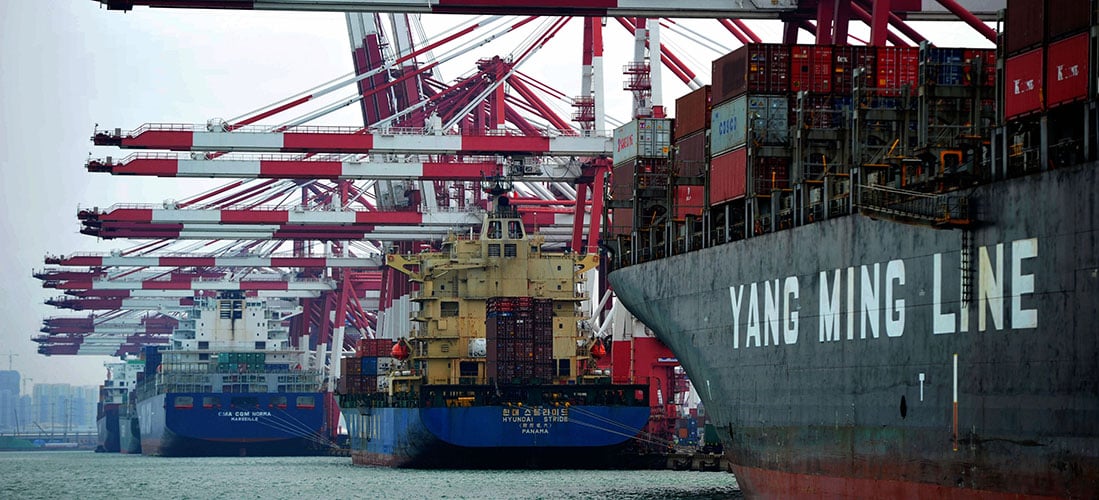May 24, 2017
Versions عربي (Arabic), 中文 (Chinese), Français (French), 本語 (Japanese), Русский (Russian), and Español (Spanish)
[caption id="attachment_19900" align="alignnone" width="1099"] Container port, Qingdao city, China. Trade with China has helped improve living standards in advanced economies through higher productivity (photo: Imagine China/Newscom)[/caption]
Container port, Qingdao city, China. Trade with China has helped improve living standards in advanced economies through higher productivity (photo: Imagine China/Newscom)[/caption]
Advocates of protectionist policies in advanced economies blame job losses on growing trade with China, and influential researchers have provided some empirical backing for their claims. Yet the benefits of trade with China are often overlooked. Among them is faster growth in productivity—the key driver of improved living standards. This suggests that rather than erecting new barriers to trade, advanced economies should continue to open up—while doing much more to help those who have lost their jobs to overseas competition.
Our new research shows that for advanced economies:
- Productivity growth has been faster in countries and industries that have been more exposed to China’s opening to trade, all else equal; and
- As much as 12 percent of the increase in productivity over the 12 years from 1995 through 2007 can be attributed to China’s integration into world trade.
Trade improves productivity in three important ways. First, imports expose domestic firms to greater competitive pressure, while giving them access to more and better inputs. Second, exporters increase productivity by learning from overseas customers and through exposure to competition from foreign producers. Third, alongside productivity gains within firms, trade fosters reallocation of resources between firms, toward the most productive.
Our research quantifies all three gains simultaneously, using data on productivity and employment as well as exports (by destination country) and imports (by source country) for 18 manufacturing and non-manufacturing sectors across 18 advanced countries. The sectors we studied were in broad categories such as textiles, and transportation equipment.
Slow recovery
Trade with China grew steadily between the mid-1990s and the mid-2000s, then declined as a result of the global financial crisis, and has recovered only slowly since then, particularly on the import side. We calculated that those exports and imports may have accounted for about 1.9 percent out of the total 15.6 percent rise in total factor productivity—the overall productivity of both labor and capital, which reflects such elements as technology—in the typical sector in advanced economies from 1995 to 2007. This is a large figure—about 12 percent of the total productivity increase in the typical sector. Also, we estimate that exposure to Chinese imports and access to China’s market each contributed about half of this gain.
The flip side of these productivity gains, however, has been net job losses. We found that job losses in advanced economies resulting from rising imports from China more than offset gains from growing exports to China. The result: net job losses of about 0.8 percent of total employment for the typical sector over the period 1995–2007.
Reap gains, ease losses
Without China’s opening-up to global trade, the productivity slowdown that started before the financial crisis of 2008–2009 would have been even sharper. The implications for policymakers in advanced economies are clear: keep opening up trade to help revive dismal productivity growth—the key source of progress in living standards—but act more forcefully to address associated labor market dislocations, notably by easing the transition of displaced workers to new jobs and industries. This involves carefully-designed active labor market policies, including retraining, job search assistance and relocation support, but also lifelong learning programs to strengthen workers’ adaptability to changing labor market needs—whether driven by trade, technological change, or some other factor.
Today, China’s trade with advanced economies is cooling as it becomes more fully integrated into the global economy. As a result, the productivity gains that advanced economies are reaping from trade with China are waning—and so are those reaped by Chinese firms. Cutting remaining trade barriers in both advanced economies and emerging markets—including China—would provide a much-needed boost to firm-level productivity in both country income groups. New restrictions, on the other hand, would risk a partial reversal of the productivity gains that have been achieved so far.
Separating Cause and Effect
If trade boosts productivity, we should see that countries and industries that have been more exposed to China’s rise in global trade experienced faster productivity growth, all else equal. However, identifying the causal effect of trade on growth is challenging: it could be that countries and industries that experienced faster productivity growth demanded more imported inputs and exported more to foreign markets as they became more competitive. To the extent this were the case, growing trade with China would at least partly result from—rather than drive—productivity growth and, consequently, we would overstate its benefits.
We address this thorny issue in two steps. First, we isolate the part of rising trade with China that was driven by China’s opening-up to trade rather than by demand from advanced economies. How do we do this? Let’s take the hypothetical example of Chinese textile exports to Italy. Intuitively, the more widespread is China’s penetration across all advanced markets, the more increased imports from China by Italy are likely to reflect China’s growing competitiveness rather than increased Italian demand. We rely on a similar intuition for exports to China: the more a country’s rising exports to China in one sector correspond to rising exports by other advanced economies, the more likely they are to be driven by China’s growing appetite for imports in that sector.
Next, we estimate the impact of that liberalization-driven integration of China into world trade on productivity in advanced economies’ industries. We find that both exports to and imports from China have increased sectoral productivity in advanced economies.




